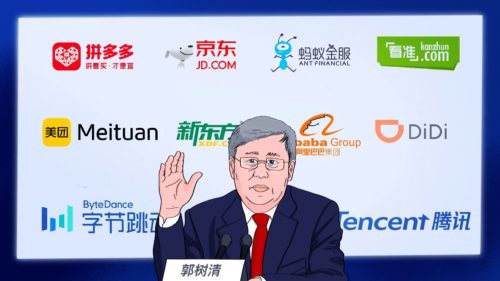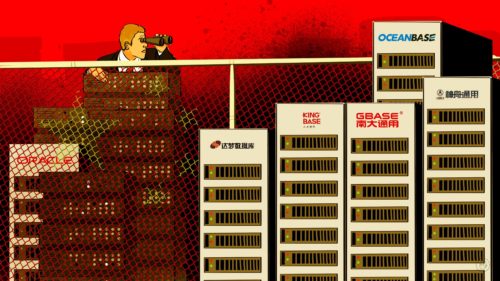Beijing is going to restrain Ant, not kill it
Alibaba affiliate Ant Group is taking a hammering from regulators, but the government’s intent is to tame the fintech giant, not ruin its business.

The saga of China’s Alibaba affiliate and fintech giant Ant Group over the past few months has had something for everyone — hijinks around the role of charismatic founder Jack Ma (马云 Mǎ Yún), political intrigue and insider politics, personal affronts to senior Chinese leaders, including Xí Jìnpíng 习近平 himself, and large and influential Western investors left at least temporarily holding the bag as the world’s biggest IPO had the rug pulled out from under it days before it was scheduled to go public. The issues raised by the spectacle of the Ant IPO will be with us for some time, and point to major issues within China’s regulatory system, and the ability of large and successful firms such as Ant to navigate the changing political and regulatory environment, within the limitations the system is now imposing.
The challenge in understanding what is happening to Ant is that it both involves deep domestic political currents, and also reflects Beijing’s view of how to regulate its leading tech and financial services (really fintech) companies in the midst of what will be a protracted technology conflict with the U.S. and potentially a broader set of like-minded countries.
Hence, Beijing must carefully balance its desire for greater regulatory control and minimizing systemic risks with the desire to ensure that China can continue to field large, capable tech champions like Ant that can compete globally with U.S. companies. Beijing wants to restrain companies like Ant, but it also wants them to be seen as viable investment vehicles for global capital markets, as Beijing is eager to have the world increasingly look to China as a stable growth engine going forward.
Indeed, communicating regulatory deliberations and decisions to the global investment community in ways it can understand, and playing down the major political overtones of a situation like the pulled Ant IPO will remain major challenges for Beijing. Investors need to have some certainty that their investments will not be endangered over political infighting, perceived slights to political leaders by company executives, or other actions that are unrelated to a company’s business performance, market position, and ability to deliver a suitable return to investment over the long term.
In late January, the governor of the People’s Bank of China (PBoC), Yì Gāng 易纲, stated that Ant’s IPO could be back on track if the company fixes its problems, indicating regulators’ initial confidence that it will be possible to resolve key government regulatory concerns around Ant. This comment presents a significant milestone in the regulatory convulsions kicked off in the wake of an October speech given by Jack Ma and the shocking postponement of its massive IPO, and indicates that over the long run, Chinese regulators are likely to take a balanced view of Ant. The intent is to draw a regulatory framework to ease financial risk while fostering innovation in the fintech sector, while remaining susceptible to the Party leadership’s power dynamics.
Ant to-do list: Front more money, expand Chongqing lending permit, cede market share?
So far, China’s leading financial regulators have identified three broad categories of problems with Ant, namely:
- Potential violations of financial rules
- Unfair competition practices
- Questionable data handling
Failure to comply with sectoral regulations appears to be the company’s most serious misconduct in the eyes of financial officials. Around the time regulators pulled Ant’s IPO, the China Banking and Insurance Regulatory Commission (CBIRC) and the People’s Bank of China (PBoC) proposed the Interim Measures for the Administration of Online Microlenders (in Chinese) — these measures would appear to significantly lower Ant’s lending leverage, and hence reduce its valuation.
It is possible that Ant founder Jack Ma was hoping to front-run this tightening effort with his public criticism of banking authorities at the Bund Summit in late October. However, he clearly badly misjudged the political and regulatory environment, angering both elements of the system, setting off just the situation he had hoped to avoid.
Having failed to head off a new regulatory campaign, Ant will very likely be obligated to meet the Measures’ requirement for providing 30% of any loans the firm jointly funds with banks, a significant increase from the current 2% level that Ant maintains. This means that the company would need a capital injection of nearly $22 billion to close the gap.
The Measures also require microlenders to be approved by the central government before operating across the country. Currently, Ant is doing business nationwide with licenses issued under the fairly liberal fintech policy regime of the Chongqing municipal government. Under the new rule, Ant will have to cease its lending operations outside of Chongqing until Beijing authorizes a national permit. More recently, financial regulators also proposed (in Chinese) to limit commercial banks’ ability to work with online lenders or outsource risk management functions to vendors like Ant, further undermining the fintech giant’s market position.
Another major grievance presented by the financial regulators is Ant’s unfair competition practices. In late January, the PBoC proposed another rule to limit Ant’s market power. The draft Administrative Measures for Non-Bank Payment Agencies stipulate that any non-bank payment company with half of the market in online transactions, or two entities with a combined two-thirds market share, could be subject to antitrust probes. The PBoC can suggest imposing restrictive measures on monopoly or duopoly players, including breaking them up. At present, Ant’s Alipay is estimated to hold nearly a 55% market share, followed by Tencent-backed WeChat Pay at around 40%. It is likely that Ant will have to cede some of its market power in order to avoid further antitrust scrutiny.
Fintech microlending will survive major crackdown
This is not the first time fintech companies have faced a regulatory backlash in China. Beijing has always viewed private businesses’ lending activities as a potential systematic financial risk. When the online peer-to-peer (P2P) lending platforms first emerged, regulators held a positive view of what was seen as a novel financial service model that enables individuals to obtain loans directly from other individuals, cutting out financial institutions as the middleman. It provided a new finance channel for the individuals and small businesses underserved by the state-owned banks and introduced fresh liquidity to the market.
However, the underregulated P2P business quickly attracted a large volume of capital as well as under-detected fraudulent practices. It was estimated (in Chinese) that in 2016 over 40% of the P2P platforms were in fact Ponzi schemes. By November 2019, the regulators gave (in Chinese) P2P lenders two years to exit the industry unless they were able to meet stringent capital requirements. This effectively shut down the majority of P2P businesses in China, resulting in $115 billion losses for investors according to one assessment by the China Banking Regulatory Commission.
In contrast with the P2P companies’ extensive fraudulent activities, however, Ant’s anti-competitive behavior is clearly a much more benign problem — though the political dimensions of Ant’s problems may be more difficult. Therefore, the initial regulatory crackdown on Ant is likely to be less damaging. Compared with the forced exit order for P2P firms, restructuring Ant in compliance with the new capital, licensing, and market share requirements is a much more tractable problem that can be done incrementally. This approach reflects regulators’ proportional response to the financial risk associated with fintech microlending activities.
Regulators want to harness and direct Ant’s power, not kill it
Financial authorities also likely weighed the financial risk against the economic and social benefits of fintech microlenders and decided to keep Ant in the market, while issuing new rules designed to provide a level playing field between traditional banking institutions and online lenders.
In fact, Chinese government officials long recognized the benefits to the economy and society provided by Ant’s business model, even amidst the tightening scrutiny. In a December interview (in Chinese), deputy governor of PBoC Pān Gōngshèng 潘功胜 acknowledged Ant’s contribution to fintech development, financial service improvement, and financial inclusion, and highlighted fintech as a force of economic growth in the “Dual Circulation” era (Dual Circulation is Xi Jinping’s phrase for strengthening the domestic economy while staying a player internationally).
In late January, Pan penned an article in the Financial Times, saying “China is trying to strike a balance between encouraging fintech development and preventing financial risks via prudent regulation.” He also underscored that China’s regulatory approach emphasizes the substance, not the form, of a company; both fintech and traditional financial institutions imply the same level of financial risk. The goal is to standardize and update financial regulations, so they are equitably applied to both types of service providers. This approach is generally in line with the U.S.’s regulatory objective to supervise fintech as tightly as other financial services, which is more conservative than the direction taken by the U.K. The U.K. proactively established the first fintech regulatory sandbox in 2015 and has achieved global regulatory leadership in this area (the “sandbox” is a set of rules that allow startups to operate freely within a controlled environment under a regulator’s supervision).
Intent to mitigate financial risk while promoting fintech innovation, China is likely to push for downsizing and reorganization of Ant to achieve deleveraging, rather than a more disruptive breakup or state takeover of the type that resulted in the dismantling of the insurance conglomerate Anbang Group.
Looking forward, Chinese financial regulators may view innovative financial service offerings with more caution and consider expanding existing regulatory sandbox pilot projects to cover emerging fintech business models. Such action may potentially point to more alignment with the global fintech sandbox regulatory trend set forth by the U.K. So far, over 25 countries have launched such regulatory experimental mechanisms.
For Ant, though, the regulatory rehabilitation will also probably need to be accompanied by a period of political rehabilitation. This means Jack Ma, who holds a controlling stake in Ant, probably won’t fully recover his previous status as the firm’s public face domestically and internationally. And in the future, Chinese officials overseeing large-scale IPOs of the type Ant had pushed for will face the continuing challenge of dealing with sensitive issues around how controversial business figures and well-connected individuals are going to be handled if the size of an IPO means huge potential windfalls for those on the inside.
However, the fintech platform’s potentially troublesome political ties exposed by the media may have been overemphasized. So far, there are no signs that Beijing regards Ant’s political connections as amounting to outright corruption — such a determination would lead to more serious charges against company officials and potentially a shift in ownership structure.
But for now, Chinese financial regulators — widely viewed as the most professional and internationally minded of the country’s sectoral rulemakers — appear to have struck a balance in dealing with the thorny issue of Ant, its founder’s outspokenness, its anticompetitive practices, and how to thread the needle in a way that avoids drastic measures that would debilitate the firm’s business model or further destabilize the market.







